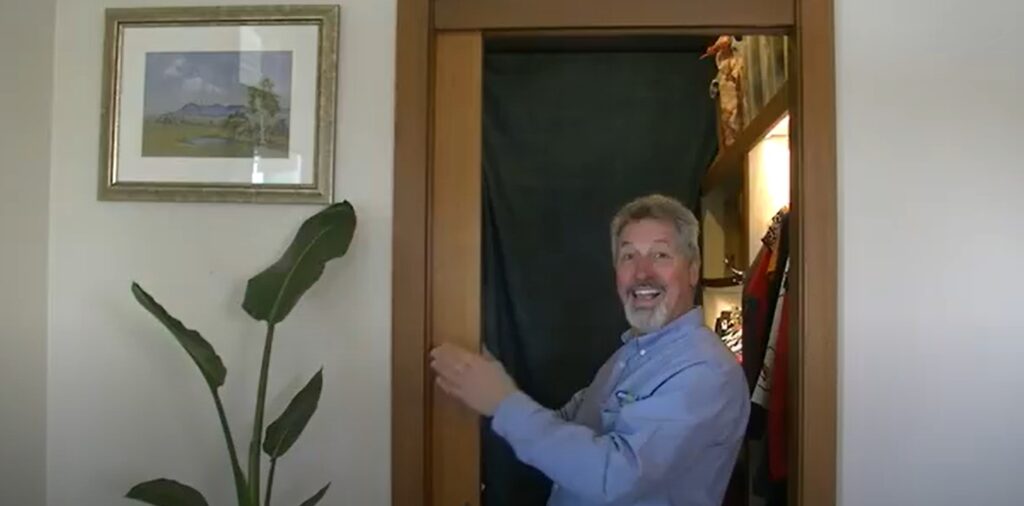
Have you ever experienced a draughty sliding door? Maybe you have a cavity sliding door in your home that opens into an external wall? Well, I have some great news for you! Today, Maurice Beinat, Technical Director at ecoMaster, will show us how to fit the Draught Dodgers Cavity Sliding Door kit to a sliding door to ensure that it is completely draught proof, with a Cavity Sliding Door Kit.
Before we begin, let’s learn a little bit about why a sliding door can be draughty, especially ones that open into the external wall. The back of the cavity in these doors is open to the external wall cavity, which is heavily ventilated. This means that draught can easily come in or go out, depending on the direction of the wind. Nobody likes a draught, especially when it leads to higher heating or cooling costs, so let’s get started on how to fix it!
Firstly, we need to clean everywhere that we’re going to fit the components to the door and the door jamb. This is to maximize the adhesion of the adhesive. Next, we may need to adjust and possibly cut the bottom guides of the door. This is to ensure that there is enough space on the side between the door and the jamb on the side where we’re fitting our components. It’s also to allow smooth running of the bottom seal into the cavity.
The third step is to fit the draught proofing to the head of the cavity sliding door. Fourthly, we fit the latch side, where the door bucks into. Next, we fit the bottom draught excluder. Finally, we fit the two components that go on the trailing edge of the door. That’s one component on the face of the door and the other component that goes on the jamb.
The next thing to do is clean your cavity sliding door.
Ensuring proper installation of components on a door is crucial for their longevity and performance. The success of the installation can be affected by a number of factors, including the cleanliness of the surface where the components will be placed. In this blog, we will take a look at the first step in installing components on a door, which is to clean the perimeter where the components will be placed.
Before starting the installation process, make sure you have all the necessary tools at hand – alcohol wipes, a microfiber cloth damp with water, or a little bit of methylated spirits, depending on your preference. The key is to ensure the surface where you will be fitting the components is spotlessly clean and dry, which will allow the adhesive to have maximum holding power.
To start, identify the areas where the components will be placed. These typically include the head of the door, the trailing edge, the latch side, and the bottom edge of the door. Now, using your preferred cleaning tool, thoroughly clean these surfaces, including any hard-to-reach areas like corners or edges where the door slides into the cavity.
Remember to take special care when cleaning the trailing edge, as this is where you will be fitting more than one component. Use a long knife, if necessary, to ensure that you can clean all the way in. And don’t forget to clean the face of the door, as well.
Once you have thoroughly cleaned the perimeter of your cavity sliding door, you are ready to begin fitting the components. By starting with a clean surface, you ensure a solid foundation for the components, which ultimately leads to a well-performing door. In the video below Maurice shows every step of the process.
At this point, we are ready for fitting. One of the most important aspects of installing a cavity sliding door kit is getting the seal on the face of the back of the door just right.
The seal needs to be able to slide into the cavity, and for that to happen, the gap needs to be big enough. The top gap is usually okay, but sometimes the bottom gap is too small. This is where the guides at the bottom come in. They help to keep the door in place and prevent it from swinging open, but they can also obstruct the installation of the seal.
If the guide is one piece, it will get in the way of fitting the seal. The solution is to spread the guides out a little bit by cutting the bottom of the guide. If the guide is made of plastic, it’s easy to unscrew it, cut the plastic on the side that needs treatment, and then put the guide back on.
Be sure to treat one side first, so you have enough room on the other side to fit the seal. If your door is on a hard floor usually these guides are plastic, so it’s pretty easy to unscrew them, take them off and just cut the plastic on the side that you’re treating. Then you can put the guide back on and you can fit the guide on the side that you’re not treating first so that you’ve got enough room on the other side.
Once the seal is fitted, the guide can be put back on. It’s crucial to get the guides at the bottom right so that the seal can be installed correctly. If the guides are not appropriate, the door might not slide smoothly, which can cause damage to the door and make it difficult to close it properly.
Once we’re done with that, we start by measuring the top of the door and cutting the component for the head of the door. The shorter component comes fitted with a brush.
Always ‘measure twice, cut once’, we carefully square cut the Draught Dodger with the brush already fitted in it. Now we can fit it to the top of the door. To do this, we use a fitting packer with a pointy edge that fits underneath the shoulder of the Draught-Dodger. It’s crucial that it fits under the shoulder of the Draught Dodger and not the brush, otherwise, you’ll be fitting in the wrong place.
Remove approximately a hundred millimetres of the lining tape and start tacking the Draught Dodger on, moving the fitting packer along and removing the liner as we go. We press it hard into the head of the door to ensure it bonds well with the timber.
The Draught-Dodger is the only component that contacts the door and it’s important to note that there’ll be a slight sound from it when the door is operated. However, this sound is negligible compared to the comfort you’ll enjoy from having a draft-free home.
With this simple process, you can say goodbye to those pesky drafts and welcome a comfortable living environment. Installing a Draught-Dodger is not only beneficial for your comfort, but it also helps reduce your energy bills by keeping the warm air in and the cold air out. So what are you waiting for? Get your Cavity Draught-Dodger kit for Cavity Sliding Doors today and take the first step to a draft-free home. In the next video, you can see how to use the fitting packer correctly for this passage.
Time to fit the latch side moulding! Double chack and make sure that you have cut the moulding exactly to size. Then take off a portion of the protective liner to reveal the sticky backing.
Next, take the fitting packer and place it on the door. Place the moulding against the fitting packer and push it up to meet the other one. Once you have lined it up correctly, tack it onto the jamb by moving the fitting packer down and holding the moulding against it. Ensure that the majority of the pressure is on the thin side of the moulding to prevent any damage or breakage.
When you are moving down from the top of your cavity sliding door, press the seal hard up against the moulding. This will make sure that the seal is secured in place. It’s important to have a good square end to start with and then work your way down to the bottom. Pushing the spline in as you go will ensure maximum adhesion.
Bear in mind that the latch side takes the larger seal, so make sure you start with a good square end. Start at the top and work your way down to the bottom and push the spline in and start moving down. This seal has to be hard up against the moulding. So, sometimes you just need to go over it again to push it in all the way.
Hang on, we are almost there! Now cut the seal to size and press it in. Again, you can watch the following video where Maurice will follow every step on this passage.
It is now time to measure the jamb width. Add 10 millimeters to the width, as this is the part that will go inside the jamb. Take note of the measurement, and cut the draught excluder to size. Check the fit by placing it on the bottom of the door – it should start at one end of the door and go along to the other.
Now, it’s time to fit the draught excluder. Peel off a little bit of the liner, but be careful because it tears easily. Line up the draught excluder on the end of the door and tack it on. Close the door and push the draught excluder down slightly, so it creates a seal. Peel off the rest of the liner, and press down hard on the draught excluder, using a knife to push it into place.
When it’s properly fitted, the draught excluder should be flexible enough to bend around any deformities in the floor. Now press hard into the door; we may need to press the back of it there as well. And that’s the bottom draught excluder!
Now it’s time to cut the Draught Dodger moulding to the appropriate size by measuring from the floor to the edge of the top Draught Dodger. Once cut, fit the seal to the face of the door with part of it inside the cavity. Make sure that when the seal is fitted, the centre can still be seen when sighting along the edge.
Next, press out the trailing edge seal using a long knife or another appropriate tool. Double-check that it slides in and out of the cavity without any issues.
Then, fit the trailing edge moulding. Make sure to start with a square edge on the seal and press it into the groove all the way down. Refit the guide on this side to prevent the door from flapping around.
It’s time to fit the final component (wohoo!), starting with the Draught Dodger with the small seal onto the trailing edge. Carefully fit it so that the seal doesn’t quite touch the door but bumps into the seal previously fixed to the door itself. Lastly, fit the Draught Dodger onto the trailing edge by carefully positioning it so that it doesn’t rub against the door when closed.
Take your time and be careful when fitting the Cavity Sliding door kit. You may need to cut the bottom guide so that the bottom seal has a clear path into the cavity. The trailing edge seals may also be a bit fiddly, but it’s worth it to get them right so that they but up against each other and create a good seal. Additionally, staining and finishing the Draught Dodgers prior to fitting is preferable but can also be done afterwards. However, be careful not to stain and varnish the sills themselves and especially the brush on the very top.
Take your time and follow these steps for optimal effectiveness. and start enjoying the benefits of a draught proofed cavity sliding door, that will prevent heat loss during the winter and heat gain during the summer, reducing your heating and cooling costs and making your home more comfortable. Additionally, draught proofing also helps to reduce noise pollution and keeps dust and drafts at bay, contributing to a healthier and more pleasant indoor environment.
What’s Next?
We hope this article has helped you learn how to get rid and stop the draughts coming through your cavity sliding door This in turn will help you on your energy and thermal efficiency retrofit journey to make your home more comfortable all year round, and reduce your costs and carbon emissions.
Next, explore How to Stop Draughts from Exhaust Fans and 3 in 1 Fans.
If you found this article helpful, then please subscribe to our YouTube Channel. You’ll find many more helpful “How To” videos there. You can also follow us on Facebook and Instagram to stay in the loop.For more great information on how to make your home more energy and thermally efficient subscribe NOW to ecoBites. ecoBites are free bite size chunks of the latest energy efficiency information making it quick and easy for you to absorb.

Install your Cavity Sliding Door Kit now


Recent Comments